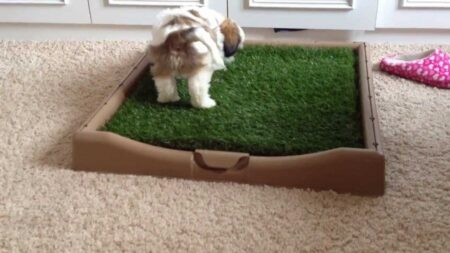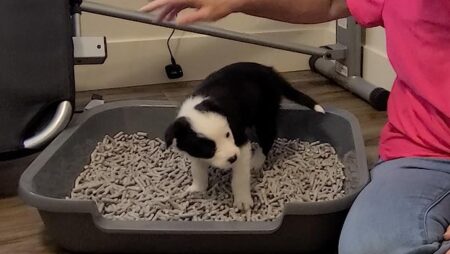Yes, it is possible to train dogs to use a litter box, although it may not be as common as training them to go outside. Some dog owners choose to train their dogs to use a litter box for a variety of reasons, such as living in an apartment with limited outdoor access or having difficulty taking the dog outside due to personal mobility issues.
The success of training a dog to use a litter box will depend on the individual dog’s temperament, age, and previous potty training experience. It may also take more time and effort compared to traditional potty training methods, as it goes against a dog’s instinct to eliminate outside.
Can You Train Dogs To Use A Litter Box?
Yes, it is possible to train some dogs to use a litter box, but it is not as common or as easy as training cats to do so. Most dogs are not naturally inclined to eliminate in an indoor box, and they may need extra training and patience to learn this behavior. The most important thing when training your dog to use a litter box is to start with positive reinforcement and praise when they do use the box. Additionally, you may need to restrict your dog’s access to other areas of the house, and gradually introduce the litter box to them. With time and patience, most dogs can learn to use a litter box.
Why Should We Train Our Dogs to Use a Litter Box?
There are several reasons why training your dog to use a litter box can be beneficial:
- Convenience: Having a litter box-trained dog can make your life a lot easier. You no longer have to rush home to let your dog out for potty breaks or deal with accidents in the house. You can simply leave out the litter box and your dog can use it whenever they need to.
- Travel: If you are someone who likes to travel with your dog, having a litter box-trained dog can make it much easier. You don’t have to worry about finding a suitable place for your dog to go potty, as they can use their litter box in any location.
- Bad weather: In extreme weather conditions, such as heavy rain or snow, it can be difficult to take your dog outside for potty breaks. Having a litter box-trained dog eliminates this problem.
- Apartment living: If you live in an apartment or a high-rise building, it can be a hassle to take your dog down multiple floors for potty breaks. A litter box-trained dog can use the box inside your apartment, making it more convenient for both you and your pup.
- Health reasons: There may be times when your dog is unable to go outside for potty breaks due to illness or injury. In these situations, having a litter box-trained dog can be a lifesaver.
- Older or disabled dogs: Older dogs or those with mobility issues may find it difficult to go outside for potty breaks. A litter box can provide an easy and safe alternative for them to do their business.
- Puppy training: Litter box training can be a great option for puppies who may not be fully house-trained yet. It can also make the house training process easier and less stressful for both you and your puppy.
Litter Box Training A Dog: Pros And Cons
Pros:
- Cleaner Environment: Litter box training a dog can help to keep your home cleaner. Dogs can create a mess by eliminating in various places around the house, but a litter box provides a designated spot for them to do their business. This can prevent accidents and keep your floors and furniture free of urine and feces.
- Convenience: Having a litter box for your dog can save you time and effort, as you won’t have to take them outside for every potty break. This can be especially helpful for people with busy schedules or for those who have difficulty walking or are unable to take their dog outside regularly.
- Suitable for Small Dogs: Some small dog breeds may have difficulty holding their bladder for extended periods, especially when they are young. Litter box training can provide them with a suitable and easily accessible option for relieving themselves.
- Useful for Housebound Dogs: Dogs that are confined to a small living space, such as an apartment, may not have regular access to the outdoors. Having a litter box can provide them with a safe and easy way to eliminate them without having to rely on their owner to take them outside.
- Useful for Senior Dogs: Senior dogs may have difficulty holding their bladder for long periods or have mobility issues that make it difficult for them to go outside. Litter box training can provide them with a convenient and accessible option for relieving themselves.
Cons:
- Potential for Mess: Litter box training a dog can create mess and odors inside your home. If the litter box is not cleaned regularly, it can become smelly and unhygienic. Also, dogs may track litter around the house, causing a mess.
- Potential for Housebreaking Issues: Litter box training a dog may confuse them with regards to where they should eliminate, especially if they are also being trained to go outside. This can lead to housebreaking issues and accidents in the house.
- Potential for Litter Ingestion: Dogs are curious and may ingest the litter, which can lead to gastrointestinal issues and can be harmful to their health.
- Behavior Changes: Some dog owners have reported changes in their dog’s behavior after being litter box trained. Some dogs may become more anxious or aggressive, as they may feel confined in a small space to do their business.
- Difficulty for Large Breeds: Litter box training may not be practical for large dog breeds, as they may not fit comfortably in a litter box and may have a harder time controlling their bodily functions in a confined space.
Outdoor Dog Litter Box Vs Indoor Dog Litter Box
Outdoor Dog Litter Box:
- Location: An outdoor dog litter box is usually placed outside or garden, away from the main living area of the house.
- Material: Outdoor dog litter boxes are typically made of durable and weather-resistant materials such as plastic, wood, or metal.
- Size: These litter boxes are larger compared to indoor dog litter boxes as they are designed to accommodate bigger dogs.
- Drainage: Outdoor dog litter boxes usually have a drainage system in place to dispose of the urine and prevent the box from getting dirty.
- Maintenance: These litter boxes require regular cleaning and maintenance as they are exposed to the elements and can become dirty quickly.
- Nature-friendly: Outdoor dog litter boxes are more environmentally friendly as they allow the dog’s waste to be disposed of in an outdoor area, rather than being kept inside the house.
Indoor Dog Litter Box:
- Location: Indoor dog litter boxes are typically placed inside the house, in a designated area such as a laundry room, bathroom, or balcony.
- Material: These litter boxes are usually made of lighter materials such as plastic, as they do not need to withstand harsh weather conditions.
- Size: Indoor dog litter boxes are smaller in size compared to outdoor ones, as they are designed for smaller dog breeds.
- Absorbent material: These litter boxes often use absorbent material such as shredded paper or wood shavings to soak up urine and prevent odors.
- Odor control: Indoor dog litter boxes may come with a cover or a tray to help control odors and prevent them from spreading throughout the house.
- Convenience: As indoor dog litter boxes are placed inside the house, they are more convenient for pet owners and are easier to access for cleaning and maintenance.
How To Start Litter Box Training A Dog
If you’re a dog owner who is tired of constantly cleaning up accidents in the house, litter box training your dog may be the perfect solution. While it’s not a common training method for dogs, it can be an effective way to give your dog a designated potty area inside your home. Here’s how to get started:
Choose the Right Litter Box
The first step is to choose a litter box that is appropriate for your dog’s size. If you have a small dog, you can use a standard cat litter box. If you have a larger dog, a baby pool or plastic storage bin can work well.
You’ll also want to choose a litter that is safe for dogs. Avoid litters made from clay or silica, as these can be harmful if ingested. Instead, opt for a litter made from recycled paper or wood shavings.
Introduce Your Dog to the Litter Box
Place the litter box in the area where you want your dog to go potty. Show your dog the litter box and encourage them to sniff around it. You may also want to place a few treats or toys near the litter box to make it a positive experience for your dog.
Encourage Your Dog to Use the Litter Box
When your dog shows signs that they need to go potty, such as sniffing around or circling, lead them to the litter box. If your dog goes potty in the litter box, praise and reward them with a treat.
If your dog doesn’t go potty, don’t punish them. Instead, try again in a few hours or wait until your dog shows signs of needing to go again.
Keep the Litter Box Clean
Just like with a cat litter box, it’s important to keep your dog’s litter box clean. Scoop out any waste daily and replace the litter every week. This will help prevent your dog from avoiding the litter box due to a dirty smell.
Practice Consistency and Patience
Consistency and patience are key when it comes to litter box training a dog. It may take some time for your dog to fully understand what the litter box is for and to consistently use it. Be patient and consistent in showing your dog where the litter box is and encouraging them to use it.
The Best Litter Boxes For Dogs: What To Look For
There are a few important factors to consider when choosing a litter box for your dog:
- Size and Accessibility: The litter box should be big enough for your dog to comfortably use. It’s important to consider the size and breed of your dog when choosing a litter box. Smaller breeds may do well with a standard-sized litter box, while larger breeds may require a larger size or even a designated dog litter box.
- Design: The design of the litter box should be easy for your dog to use. Some litter boxes have ramps or steps for easy access, while others may have a lower entrance for smaller or older dogs. You may also want to consider a litter box with a cover or privacy hood to make your dog feel more secure and to contain any odor.
- Durability: Look for a litter box made of sturdy and durable materials that can withstand your dog’s weight and any scratching or digging. Plastic and metal litter boxes are usually the most durable options.
- Easy to clean: It’s important to choose a litter box that is easy to clean and maintain. Consider a litter box with a removable tray for easy cleaning or one that comes with a litter scooper.
- Type of Litter: Some litter boxes may require a specific type of litter, while others are more versatile. Consider what type of litter your dog is comfortable with, and make sure it is compatible with the litter box you choose.
- Multi-cat household: If you have multiple dogs, you may want to consider a litter box that can accommodate more than one dog at a time. Alternatively, you could opt for multiple litter boxes placed in different areas of the house to cater to each dog’s needs.
- Cost: Litter boxes for dogs can range in price depending on their size, design, and features. Consider your budget and choose a litter box that meets both your dog’s needs and your budget.
- Odor control: Look for a litter box with effective odor control to keep your home smelling fresh.
- Extras: Some litter boxes may come with extra features such as built-in filters or automatic cleaning functions. These can add convenience but may also come with a higher price tag.
- Reviews: Before making a purchase, it can be helpful to read reviews from other dog owners who have experience with the specific litter box you are considering. This can give you a better idea of the product’s quality and effectiveness.
SEE ALSO: Dog Daycare Near Me: Best Doggy Day Care Services
FAQs
Q. Can a litter box be used for dogs?
A. Litter boxes can be used for dogs, but they may not be as effective or comfortable for the dog as they are for cats. For one, litter boxes are typically designed for a cat’s smaller body and shorter legs, so they may not be the ideal size for a dog.
Q. How do I get my dog to pee in the litter box?
A. The best way to get your dog to pee in the litter box is through positive reinforcement training. Start by placing the litter box in an area where your dog frequently goes to the bathroom, such as near the door or in a corner of the room. Whenever your dog pees outside of the litter box, gently guide them to the litter box and give them lots of praise when they do go in the box. Over time, your dog will begin to associate the litter box with going to the bathroom and will start to use it more often.
Q. What animals can be litter box trained?
A. Several animals can be litter box trained, including rabbits, ferrets, chinchillas, guinea pigs, and even rats and mice. These animals are all relatively clean and are naturally inclined to eliminate in a specific area.
Q. Can you train a dog to use pee pads and go outside?
A. Yes, it is possible to train a dog to use pee pads indoors and go outside when needed. However, this will require a bit of patience and consistency on your part. To start, place the pee pads in a designated area of your home where your dog can easily access them.
Conclusion
While it is possible to train some dogs to use a litter box, it may not be suitable for all dogs. Some breeds may struggle with this concept, and it is important to consider whether the litter box is the best option for your individual dog’s needs and behavior. It is also important to remember that even well-trained dogs may still have accidents or prefer to go outside, so it is important to be flexible and patient during the training process. Consulting with a professional trainer or behaviorist can also help determine the best approach for your dog.


